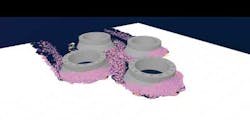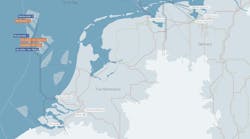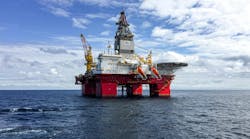Jean-Marc Letournel
Technip
Arctic and harsh winter environments are among the last remaining frontiers for offshore oil and gas extraction. Both require innovative technologies to extend current production methods into more demanding situations.
One of the greatest challenges is the presence of ice and its influence on offshore platform design. What complicates matters is that ice's physical properties can vary significantly making its behavior hard to predict.
Platforms for cold regions have typically been designed using empirically-based codes for loadings, with ice formations being modeled at scale in an ice basin using certain design criteria. What is really needed, however, is a tool that will accurately predict ice behavior, to calculate loadings, and simulate the flow of ice as it encroaches on and ideally passes by a platform structure without a dangerous build-up.
Such a tool would enable any type of structure to be optimized on a desktop computer so that design verification, through code checks and ice basin tests, becomes a formality and, most critically, the structure will behave efficiently and in a known manner at full scale. The simulator should also be able to predict transient loads during ice crushing that can and do cause adverse structural vibration, so the design can be modified to minimize this phenomenon.
A group of companies led byTechnip is developing such an ice simulation program, with Cervval, a consultancy based in Brittany, northwestern France, responsible for software development, and Bureau Veritas providing ice expertise and program verification. Cervval was selected based on its track record in simulating complex phenomena such as traffic congestion in a city before and after the installation of a major tram route; flow within a blood vessel; and the behavior of the solid catalyst in a fluid catalytic cracker reactor. It was clear that due to the complexity of ice behavior a multi-model simulator would be required. Bureau Veritas has built experience in ice behavior through basic design appraisal of ice-breaker vessels, using the company's in-house developed IceStar program.
The project started in mid-2012 with the initial aim to develop a program to simulate the ice loadings on, and floes around, the shallow-water conical foundations that Technip had devised specifically for the northCaspian Sea region. In this area, the key objective is to profile the foundation so that drifting sheet ice is broken by bending rather than crushing, which minimizes structural transient loads and vibration, and the ice fragments pass by without any build-up or encroachment on the platform topsides. The program should also be able to simulate the effect of ice flows around multiple foundations, where each foundation can encounter either an unbroken drifting ice sheet or ice rubble created by interaction with an upstream structure.
The determination of ice loads on a conical structure often employs analytical methods proposed by Ralston1 and Nevel2 where ice failure is assumed to be by bending. However, other ice failure modes such as crushing, splitting, and shearing are possible on a conical structure. Empirical methods for ice failure based on the model test results using regress-models, such as Alexeyev et al.3, provide accurate results but only where the structure shape of interest has been modeled. Various numerical methods have been proposed and developed, such as finite element modeling, but these too have limitations. So the objective of the current project is to combine knowledge of ice behavior from a variety of sources to create a complete tool for ice design. To achieve this, a variety of algorithms are combined in the same software using multi-models to cover different ice behaviors and scales. Each model has its own advantages and drawbacks and is only regarded as valid in certain circumstances.
In addition to the complexity of ice behavior, the simulator has to deal with an almost infinite number of ice particles. As an unbroken ice sheet encroaches on a structure, the loadings on the structure increase until they are sufficient to fracture the ice. The ice fracture is predicted by the program and an ice fragment is created. Each ice fragment has its own shape, mass, and center of gravity, and acts on its surroundings: the structure, seabed, ice sheet, or other ice fragments through collision, friction, load, and stress; or water, through buoyancy and drag forces. Each newly created ice fragment is subject to external loads and may fracture again if these exceed the failure criterion and thus form additional ice fragments. As a result, a typical simulation has to predict the behavior of many thousands of individual and unique ice particles.
To date, the simulator can model the encroachment of ice on a conical structure or group of conical structures. The program can predict horizontal and vertical loads on the structure with good accuracy against model test results. The build-up of ice rubble on the structure above and below the water line also matches well with observed data. This version of the simulator assumes ice fracture occurs entirely due to bending.
The program is currently being developed to simulate ice failure by crushing (in addition to bending) to simulate the encroachment of sheet ice on an inclined or vertical wall such as an artificial island. The final stage of the development during 2014 will extend the program to the modeling of floating structures. The ultimate goal is to have a fully functioning simulator that can be used for the design optimization of any fixed or floating platform sub-structure subject to ice conditions. A detailed technical paper describing the development of the simulator and its verification program was presented by Technip, Cervval, and Bureau Veritas at the Arctic Technology Conference in Houston in February 2014.
References
1 Ralston, T. D. (1980). Yield and plastic deformation in ice crushing failure. Sea Ice Processes and Models Proceedings of the Arctic Ice Dynamics Joint Experiment , pages 234-245.
2 Nevel, D. (1992). Ice forces on cones from floes. IAHR Symposium, 11th , pages 51-61.
3 Alexeyev, Yu., Karulin, E., Karulina, M., Sutulo, S. (1998). A method for predicting ice loads on structures based on model test data. IAHR Symposium 14th, Potsdam, USA








